Lily Beetle - plant pest
also known as red lily beetle
or scarlet lily beetle
If you grow lilies - you MUST be aware of this pest and look out for it - wherever you live
Signs - Like the name suggests lilies (from bulbs) are the main plant that are attacked, though fritillaries, soloman's seal, day lilies and lily of the valley may also be eaten. The adults and larvae eat the leaves and unopened flower buds, despite the fact that the adults are bright scarlet they are not easy to spot on the plants. They are black underneath and spend most of their time under leaves so are surprisingly inconspicuous.
If you are growing lilies, you need to look out for them from the point that the shoots appear in the spring. Look at the leaves for cleanly cut scoops in the side or holes. The easiest way to see the adults I find is to bend at the waist and turn your head upside down so you are looking up the stems and at the bottom of the leaves rather than down on the stems, alternatively lay down on the ground next to your lilies and look upwards. If you find one lily beetle, you can bet you'll get lots more. The overwintering adults arrive first emerging from the soil to lay their eggs in early to mid spring once there are lilies to feed on. The larvae then appear and cause the real damage.
The larvae are very inconspicuous as they cover themselves with sticky black excreta which if you've never seen them before doesn't look anything like an insect that can devour your lovingly cared for lilies in next to no time.
The eggs are tiny, but are bright orange/red and laid in groups of up to 15, so they are surprisingly easy to see for their size - they are only laid on the underside of leaves.
These pests can destroy your prized lilies in a very short time - if you grow lilies, you have to be vigilant.
Damage - The beetles, both adult and larvae have a particular liking for the emerging flower buds, so the years flowers can rapidly be completely destroyed before you have even seen them unfurl as small buds. They will also start on the leaves and strip them. The bulb may be able to lay down reserves for next years flowers if it has leaves (but how disappointing to find out the buds have been pinched out just as they were about to do their thing), though not if the leaves are also removed.
Treatment - A two pronged attack, pick off and crush the adults underfoot and use a systemic insecticide on the plant which is most effective against the larvae.
As mentioned, the adults are surprisingly good at hiding for a bright red 6-8mm long beetle. Look under the leaves, pick them off and tread on them, this may affect your sensibilities, but it is organic! Once you've had a favourite lily attacked by lily beetle, you will find it easier to pick them off and tread on them.
A systemic insecticide applied every 4-6 weeks according to instructions is the most effective means of combating lily beetle. This kind of insecticide is taken in by the leaves and distributed around the plant, when the adults or larvae eat the plant, they eat the insecticide and are killed, it is also residual within the plant for this time.
The lily beetle was a relatively localized pest in south east England, especially in and around London until about 2000. In the last two decades it has spread throughout Britain and is now established as far north as Scotland and Northern Ireland.
While they can be a particularly devastating pest, they are readily dealt with as long as you are aware of them and are looking out.
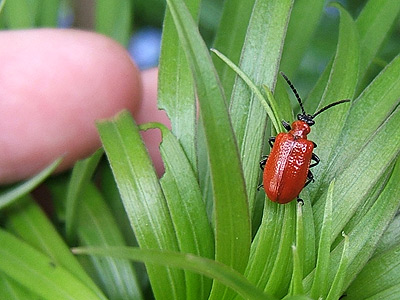
Adult lily beetle
note the damaged leaves where it or its
brethren have been feeding
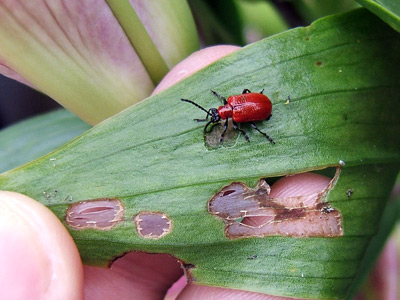
You almost never find them like this, they
are always under the leaf, it took some
re-positioning and quick photography to get
this picture, also showing characteristic leaf damage.
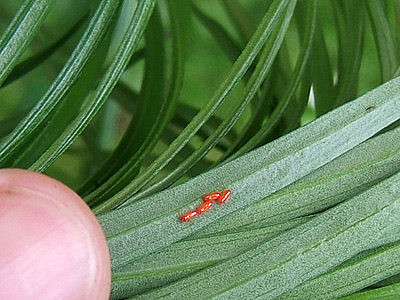
Lily beetle eggs
that's my forefinger for scale, so they are tiny, but the colour makes them stick out, they are always under the leaf
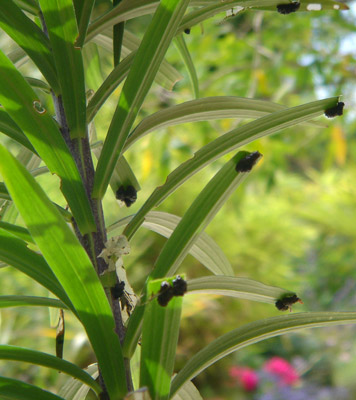
Lily beetle larvae
looking like a bit of muck on the leaf, but these are the little b**gers that will deny you those 6" wide heavenly scented blooms you were so looking forwards to
picture used permission of Holger Casselmann
published under GNU Free Documentation License,
Version 1.2

Insect
hotel / house
A sheltered insect house to help a range of beneficial
insects to over-winter in your garden. If they are over-wintering there,
they are in an ideal position come the spring and summer to wake up and
help to combat any pests you may have. Amongst others, good for ladybirds,
lacewings and solitary wasps which will help keep your unwanted garden visitors
down. Place in a sheltered place outdoors.
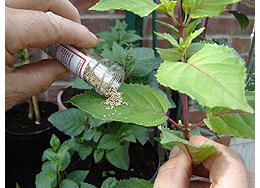
Biological
Pest Control - Organic living pest control for a variety of
problems, red spider mite, whitefly, fungus gnats (sciarid fly), thrips, mealy bug,
vine weevils and more.
These are parasites or predators that will specifically infect the pest they are brought in to control without harming any other living things and without the use of chemicals. A small population of pests needs to be maintained so that the control agent doesn't die out.

Chemical insecticides - If your plants get a heavy infestation, then I think it's acceptable to use a chemical insecticide as a "smart missile" just on that particular plant. I resort to this when the aphids build up under cover on my favourite plum tree, or other plant/s. Don't overdo it and spray too often and don't spray the whole garden "just-in-case", buy a small 1L or thereabouts sprayer so you don't get carried away.
Not pest specific.
Reasons to like lily beetles
(I find this a difficult section to write as I love my lilies and therefore hate these little sods)
- They are really quite pretty, a very fetching shade of scarlet and a well proportioned beetle, makes me feel almost guilty when destroying that elegance beneath my gardening boot.
- Lily beetles belong to the Coleoptera, the beetles, and there are more beetle species than of any other animal group on the planet by a long way, which is in itself impressive, if not terribly useful.About 25% of all animal species are beetles.
- You have to admire the audacity of a pest that is so colourful and obvious, at least greenfly have the decency to try and blend in, these seem to be saying "Yeh so?! I'm eating your lilies and I'm bright red - what you going to do about it?"
Copyright 2000 - present. All Rights Reserved | Privacy Policy Statement
